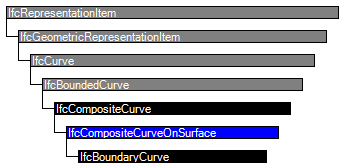Natural language names
 | Zusammengesetzte Kurve auf einer Fläche |
 | Composite Curve On Surface |
 | Courbe composite sur surface |
Change log
| Item | SPF | XML | Change | Description | IFC2x3 to IFC4 4.0.0.0 |
|---|---|---|---|---|
| IfcCompositeCurveOnSurface | ADDED | IFC4 Addendum 1 4.0.1.0 | ||
| IfcCompositeCurveOnSurface | ||||
| SelfIntersect | MODIFIED | Type changed from LOGICAL to IfcLogical. | IFC4x2 Candidate 4.2.0.0 | |
| IfcCompositeCurveOnSurface | ||||
| PositioningElement | ADDED | IFC4x2 to IFC4x3_RC1 | ||
| IfcCompositeCurveOnSurface | ||||
| PositioningElement | MODIFIED | Aggregation changed from NONE to SET. | IFC4x3_RC1 to IFC4x3_RC2 | |
| IfcCompositeCurveOnSurface | ||||
| Segments | X | X | MODIFIED | Type changed from IfcCompositeCurveSegment to IfcSegment. | IFC4x3_RC2 to IFC4x3_RC3 |
| IfcCompositeCurveOnSurface | ||||
| PositioningElement | DELETED |
Semantic definitions at the entity
Entity definition
The IfcCompositeCurveOnSurface is a collection of segments, based on p-curves. i.e. a curve which lies on the basis of a surface and is defined in the parameter space of that surface. The p-curve segment is a special type of a composite curve segment and shall only be used to bound a surface.
NOTE Definition according to ISO/CD 10303-42:1992
A composite curve on surface is a collection of segments which are curves on a surface. Each segment shall lie on the basis surface.There shall be at least positional continuity between adjacent segments. The parameterization of the composite curve is obtained from the accumulation of the parametric ranges of the segments. The first segment is parameterized from 0 to l1, and, for i ≥ 2, the ith segment is parameterized from
where lk is the parametric length (that is, the difference between maximum and minimum parameter values) of the kth curve segment.
Entity adapted from composite_curve_on_surface defined in ISO 10303-42.
HISTORY New entity in IFC4.
Attribute definitions
| # | Attribute | Type | Cardinality | Description | G |
|---|---|---|---|---|---|
| BasisSurface :=IfcGetBasisSurface(SELF) | IfcSurface | S[0:1] | The surface on which the composite curve is defined. | X |
Formal Propositions
| Rule | Description |
|---|---|
| SameSurface | The BasisSurface shall contain at least one surface (and exactly one surface). This ensures that all segments reference curves on the same surface. |
Inherited definitions from supertypes
Entity inheritance

Attribute inheritance
| # | Attribute | Type | Cardinality | Description | G |
|---|---|---|---|---|---|
| IfcRepresentationItem | |||||
| LayerAssignment | IfcPresentationLayerAssignment @AssignedItems | S[0:1] | Assignment of the representation item to a single or multiple layer(s). The LayerAssignments can override a LayerAssignments of the IfcRepresentation it is used within the list of Items.
IFC2x3 CHANGE The inverse attribute LayerAssignments has been added. IFC4 CHANGE The inverse attribute LayerAssignment has been restricted to max 1. Upward compatibility for file based exchange is guaranteed. | X | |
| StyledByItem | IfcStyledItem @Item | S[0:1] | Reference to the IfcStyledItem that provides presentation information to the representation, e.g. a curve style, including colour and thickness to a geometric curve.
IFC2x3 CHANGE The inverse attribute StyledByItem has been added. | X | |
| IfcGeometricRepresentationItem | |||||
| IfcCurve | |||||
| Dim :=IfcCurveDim(SELF) | IfcDimensionCount | The space dimensionality of this abstract class, defined differently for all subtypes, i.e. for IfcLine, IfcConic and IfcBoundedCurve. | X | ||
| IfcBoundedCurve | |||||
| IfcCompositeCurve | |||||
| 1 | Segments | IfcSegment | L[1:?] |
The component bounded curves, their transitions and senses. The transition attribute for the last segment defines the transition between the end of the last segment and the start of the first; this transition attribute may take the value discontinuous, which indicates an open curve.
NOTE : For IfcGradientCurve and IfcSegmentedReferenceCurve the segments define the interpolation between segment start and and segment end. | X |
| 2 | SelfIntersect | IfcLogical | Indication of whether the curve intersects itself or not; this is for information only. | X | |
| NSegments :=SIZEOF(Segments) | IfcInteger | The number of component curves. | X | ||
| ClosedCurve :=Segments[NSegments].Transition <> Discontinuous | IfcLogical | Indication whether the curve is closed or not; this is derived from the transition code of the last segment. | X | ||
| IfcCompositeCurveOnSurface | |||||
| BasisSurface :=IfcGetBasisSurface(SELF) | IfcSurface | S[0:1] | The surface on which the composite curve is defined. | X | |
Formal representations
XML Specification
<xs:element name="IfcCompositeCurveOnSurface" type="ifc:IfcCompositeCurveOnSurface" substitutionGroup="ifc:IfcCompositeCurve" nillable="true"/>
<xs:complexType name="IfcCompositeCurveOnSurface">
<xs:complexContent>
<xs:extension base="ifc:IfcCompositeCurve"/>
</xs:complexContent>
</xs:complexType>
EXPRESS Specification
ENTITY IfcCompositeCurveOnSurface
SUPERTYPE OF(IfcBoundaryCurve)
SUBTYPE OF (IfcCompositeCurve);
DERIVE
BasisSurface : SET [0:1] OF IfcSurface := IfcGetBasisSurface(SELF);
WHERE
SameSurface : SIZEOF(BasisSurface) > 0;
END_ENTITY;
 References: IfcCurveOnSurface
References: IfcCurveOnSurface

 EXPRESS-G diagram
EXPRESS-G diagram Link to this page
Link to this page